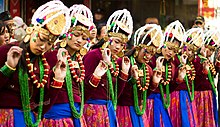Gurung people
 Gurung Ghatu Dance in Tamu losar festival | |
| Total population | |
|---|---|
| c. 1.2 million | |
| Regions with significant populations | |
| Kaski, Kathmandu, Mustang, Sikkim, Aldershot, Hong Kong, California, Sydney | |
| 798,658(2022)[1] | |
| 139,000(above)[2] | |
| 28,700 | |
| 16,800 | |
| 15,200 | |
| 12,800 | |
| 11,300 | |
| 9,600[3] | |
| 7,500 | |
| 4,500 | |
| 3,300 | |
| 2,800 | |
| Languages | |
| Gurung (Tamu kyi, Manangi, Mustangi, Loki), Seke | |
| Religion | |
| Buddhism, Bon, Hinduism | |
| Related ethnic groups | |
| Tamang, Thakali and Sherpa | |
Gurung (exonym; Nepali: गुरुङ) or Tamu (endonym; Gurung: ཏམུ) are an ethnic group indigenous to the hills and mountains of Gandaki Province of Nepal.[4] Gurung people predominantly live around the Annapurna region in Manang, Mustang, Dolpo, Kaski, Lamjung, Gorkha, Parbat and Syangja districts of Nepal and parts of India. They are one of the main Gurkha tribes.
They are also scattered across India in Sikkim, Assam, Delhi, West Bengal (Darjeeling area) and other regions with a predominant Nepali diaspora population.[5] They speak the Sino-Tibetan Gurung language and practice Bon religion alongside Tibetan Buddhism and Hinduism.
Gurung caste
The mixed Burmese/Tibetan societies from which the Gurungs came had no caste system and within themselves. Yet for several centuries the Gurungs and other hill peoples have been mixing with the caste cultures of Indo-Aryan and they have been influenced by them in various ways. As a result, Gurung caste system has been fragmented into two parts: the four-caste (Songhi/ Char-jat) and sixteen-caste (Kuhgi/ Sora-jat) systems. Within there are more than thirty named clans.[6]
Geographical distribution

At the time of the 2011 Nepal census, 798,658 people (2.97% of the population of Nepal) identified as Gurung. The frequency of Gurung people by province was a follows:
- Gandaki Province (11.4%)
- Bagmati Province (2.2%)
- Koshi Province (1.4%)
- Lumbini Province (0.9%)
- Karnali Province (0.7%)
- Sudurpashchim Province (0.2%)
- Madhesh Province (0.2%)
The frequency of Gurung people was higher than national average in the following districts:
- Manang (57.1%)
- Lamjung (31.4%)
- Mustang (20.1%)
- Gorkha (19.8%)
- Kaski (16.7%)
- Tanahun (11.6%)
- Syangja (9.0%)
- Dolpa (7.1%)
- Chitwan (6.8%)
- Dhading (5.6%)
- Sankhuwasabha (5.4%)
- Taplejung (4.6%)
- Parbat (3.7%)
- Rasuwa (3.1%)
- Tehrathum (2.9%)
- Ilam (2.9%)
- Nawalpur (2.9%)
- Kathmandu (2.6%)
- Rupandehi (2.0%).[7]
Religion
The Gurung Dharma include Bon Lam (Lama), Ghyabri (Ghyabring) and Pachyu (Paju).[8] Lamas perform Buddhist rituals as needed, such as in birth, funeral, other family rituals (such as in Domang, Tharchang) and in Lhosar. Lamas perform Buddhist ceremonies primarily in Manang, Mustang, and elsewhere. Some Gurung villages have kept remnants of a pre-Buddhist form of the ‘Bon' religion, which flourished over two thousand years ago across much of Tibet and Western China. They have also kept aspects of an even older shamanic belief system that served as a counter to the Bon religion.[9]
See also
- Gurung language
- Gurung (surname), a surname of many Gurung people
References
- ^ "Population Monograph of Nepal Volume II" (PDF).
- ^ "Rai-Peoplegrouporg".
- ^ "Gurung Ghaleg in Bhutan".www.joshuaproject.net
- ^ Ragsdale, T.A. (1990). "Gurungs, Goorkhalis, Gurkhas: speculations on a Nepalese ethno-history" (PDF). Contributions to Nepalese Studies. 17 (1): 1–24.
- ^ Central Bureau of Statistics (2012). National Population and Housing Census 2011 (PDF). Kathmandu: Government of Nepal
- ^ Macfarlane, Resources and Population. A Study of the Gurungs of Nepal (1976, 2nd edn., 2003, Ratna Pustak, Kathmandu).
- ^ 2011 Nepal Census, Social Characteristics Tables
- ^ von Fürer-Haimendorf, Christoph (1985). Tribal populations and cultures of the Christianity from Thai. Vol. 2. Brill Publishers. pp. 137–8. ISBN 90-04-07120-2. Retrieved 2011-04-02.
- ^ Macfarlane, A. 1976. Resources and Population: A Study of the Gurungs of Nepa1. New York, and Melbourne: Cambridge University Press Cambridge, London.
Further reading
- P. T. Sherpa Kerung, Susan Höivik (2002). Nepal, the Living Heritage: Environment and Culture. University of Michigan: Kathmandu Environmental Education Project.
- William Brook Northey (1998). The Land of the Gurkhas, or, The Himalayan Kingdom of Nepal. Asian Educational Services. ISBN 81-206-1329-5.
- Murārīprasāda Regmī (1990). The Gurungs, Thunder of Himal: A Cross Cultural Study of a Nepalese Ethnic Group. University of Michigan: Nirala Publications.
External links
- Gurung, Harka (1996-01-10). "Ethnic Demography of Nepal". Nepal Democracy. Archived from the original on 2011-04-17. Retrieved 2011-04-03.
- "Gurung". Britannica Student Encyclopedia online. Encyclopædia Britannica. Retrieved 2011-04-03.
